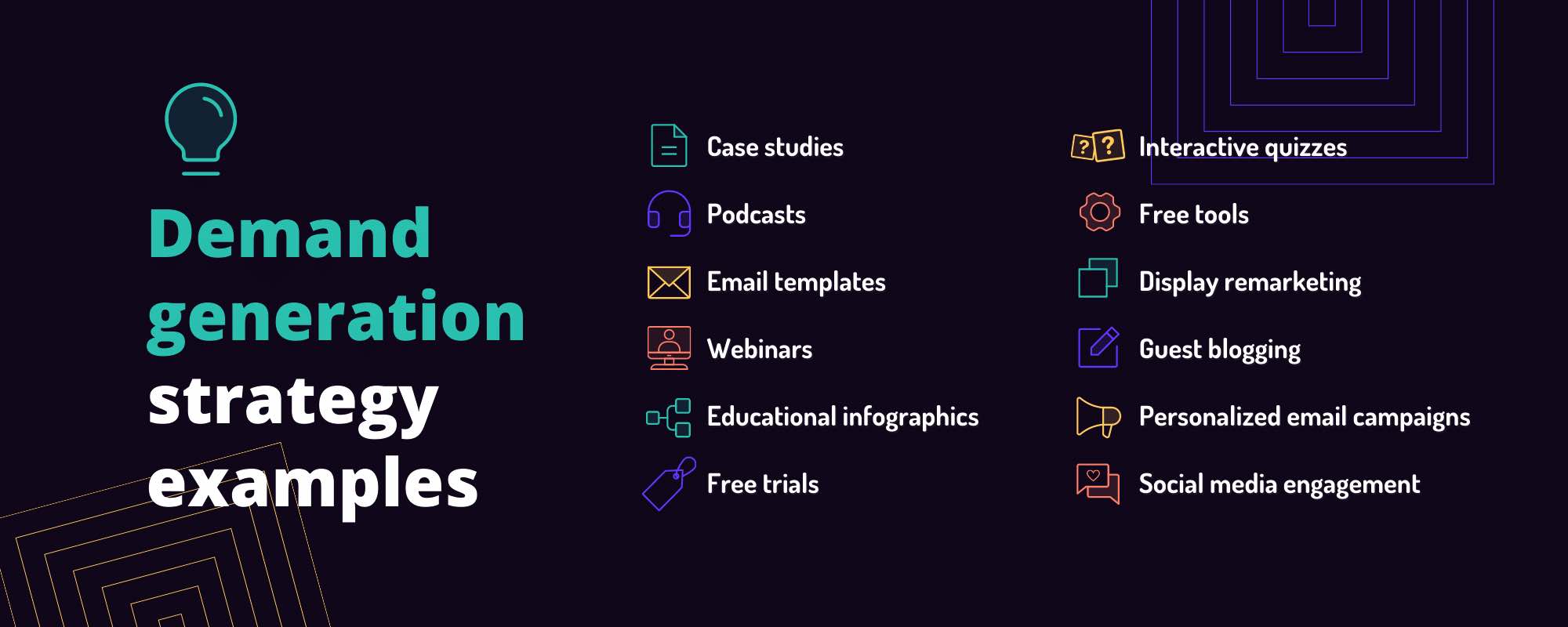Effective demand generation strategy examples









.svg)
.svg)
Identify new buyers In your target accounts
UserGems monitors your target accounts and surfaces prospects that match your persona when they've just started their new roles.
Integrate with your existing tools








Why UserGems?
Drive bigger pipeline
Increase win rate
Reduce churn
.svg)

Demand generation strategy examples
If you are looking to grow your business in the current environment, you need to think about how to generate interest in your products and services. If you can generate interest in what you do, you will have an easier time converting your prospects into paying customers. That is where demand generation is important.
As the name suggests, demand generation is the process of generating more interest in your products and services. If you’re looking for inspiration we’ve got you covered. There are countless demand generation strategy examples that you can put to work for you. But first, let’s go over some clarifying definitions.
Differences between digital marketing vs demand generation
You might be wondering about the difference between digital marketing vs demand generation. They are not the same things, but they go hand in hand. Demand generation has a specific goal of driving awareness of your products or services. On the other hand, digital marketing’s goal is to get visitors to your business’ digital properties like websites and social media profiles.
Understanding demand generation vs lead generation
As you try to find ways to get new customers to join your business it’s important to know the differences between demand generation vs lead generation.
Demand generation, as mentioned above, is to create interest in your products or services. Lead generation goal is even more specific. It involves collecting information about your target customers and turning them into leads.
Your demand generation strategy might bring in people from marketing, advertising, outbound prospecting, events, and many other sources. Once you’ve attracted your ideal prospects your lead generation strategies should help convert those leads into customers.
Ultimately, even though demand generation and lead generation are not the same, they are both crucial to the success of your business.
The typical demand generation process
When you’re building your demand generation framework, you need to learn more about the B2B demand generation tactics you might use to help you grow your company.
In today’s modern world when someone is looking for a product or service they need they often use the internet for help. Therefore, there is a good chance that this will be the first touchpoint you have with a potential client. And you need to make sure this counts.
A typical B2B prospects journey may look like this:
- They realize they have a problem and look for a product or service that solves it
- After some searching on the internet, they may land on your website
- If they want to learn more they might sign up for a demo
- Next, they will talk to the sales team
This process could go back and forth multiple times before they finally make a decision. They might see more ads and emails before the deal closes. Particularly if you are in the B2B world, this is a process that could take months. We’ll cover demand generation strategy examples that your team can use to help this process.
B2B demand generation strategy examples

There’s no shortage of good demand generation strategy examples.
- Case studies
- Podcasts
- Email templates
- Webinars
- Educational infographics
- Free trials
- Interactive quizzes
- Free tools
- Display remarketing
- Guest blogging
- Personalized email campaigns
- Social media engagement
Demand generation strategy template
If you want your sales and marketing teams to be successful, you need to develop a demand generation strategy template they can follow. Once you’ve decided on a few demand generation strategy examples to try you can test, iterate, and add the best ones to your strategic framework.
Define your target personas
When you are looking for new customers for your business, the first step is to set up an ideal customer persona. If you try to target everyone, you will target nobody, causing your strategies to fall flat.
Refine your communication cadence
You need to think about the pacing of your communication. You do not want to have long stretches of time without talking to your leads, but you do not want to talk to them all the time. Otherwise, you may drive them away.
Create content that solves your target personas' pain points
You need to focus on the pain points and the purchase process, making this as easy as possible. Create materials that you put up on your website or share via email. If you can find a way to address your leads’ pain points, you will have a much easier time converting.
Demand generation tools to use
You need to find the right tools that will help your sales and marketing teams work together. If you have the right tools in place to qualify your leads, connect them to your sales teams, and close deals in your sales pipeline.
If you are looking for a tool that can help you get the most out of your demand generation, then you need to use UserGems. You can use this tool to find new leads and figure out which ones are most likely to convert. That way, your sales teams can spend their time with people who will buy your products and services.
Want to get more pipeline with less work?
.svg)
















.svg)
.svg)



